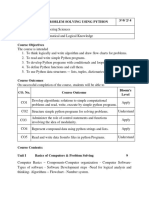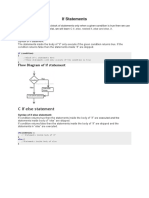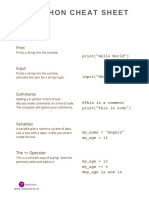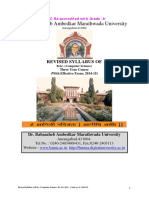Arduino Conditional Statements
Uploaded by
Rodge Lioris DocArduino Conditional Statements
Uploaded by
Rodge Lioris DocArduino Conditional Statements
What are conditional statements?
Conditional statements allow an Arduino to make decisions based on the values
of variables or sensors. This is done by using a conditional statement to check if
a condition is true or false. If the condition is true, the code inside the conditional
statement is executed. If the condition is false, the code inside the conditional
statement is skipped.
Why are conditional statements important?
Conditional statements are essential for writing complex Arduino code. Without
conditional statements, an Arduino would only be able to execute code in a linear
fashion, from beginning to end. With conditional statements, an Arduino can
make decisions and perform different actions based on the current situation.
Types of conditional statements
There are two main types of conditional statements in Arduino:
● if statements: if statements check if a single condition is true or false.
● else if statements: else if statements allow you to check multiple
conditions and execute different code depending on which condition is
true.
Basic if statements
The basic syntax for an if statement is as follows:
if (condition) {
// code to execute if the condition is true
}
The condition can be any expression that evaluates to a boolean value (true or
false). For example, the following if statement will turn on an LED if the value of
the potentiometer is greater than 500:
int potentiometerValue = analogRead(A0);
if (potentiometerValue > 500) {
digitalWrite(13, HIGH); // turn on the LED
}
If the value of the potentiometer is less than or equal to 500, the LED will remain
off.
Else if statements
Else if statements allow you to check multiple conditions and execute different
code depending on which condition is true. The syntax for an else if statement is
as follows:
if (condition1) {
// code to execute if condition1 is true
} else if (condition2) {
// code to execute if condition2 is true
} else if (condition3) {
// code to execute if condition3 is true
} else {
// code to execute if none of the conditions are true
}
For example, the following else if statement will turn on a red LED if the value of
the potentiometer is less than 250, a yellow LED if the value of the potentiometer
is between 250 and 500, and a green LED if the value of the potentiometer is
greater than 500:
int potentiometerValue = analogRead(A0);
if (potentiometerValue < 250) {
digitalWrite(13, HIGH); // turn on the red LED
} else if (potentiometerValue < 500) {
digitalWrite(13, HIGH); // turn on the yellow LED
} else {
digitalWrite(13, HIGH); // turn on the green LED
}
Conclusion
Conditional statements are an essential part of Arduino programming. By
understanding how to use conditional statements, you will be able to write more
complex and powerful Arduino code.
You might also like
- ABE-13 Arduino-Lab Chapter-III 230314 111636No ratings yetABE-13 Arduino-Lab Chapter-III 230314 11163612 pages
- ECE 513 Part1 ArduinoUnoFundamentals Ver1.2No ratings yetECE 513 Part1 ArduinoUnoFundamentals Ver1.276 pages
- Hassan S. Arduino Programming Essentials. A Practical Handbook...2024No ratings yetHassan S. Arduino Programming Essentials. A Practical Handbook...2024273 pages
- Sarful H. Arduino Programming for Absolute Beginners 2024No ratings yetSarful H. Arduino Programming for Absolute Beginners 2024428 pages
- Getting Started With Programming On ArduinoNo ratings yetGetting Started With Programming On Arduino27 pages
- Basics Arduino Programming (Supplementary)No ratings yetBasics Arduino Programming (Supplementary)53 pages
- Quarter II - Computer Science Reviewer - RayNo ratings yetQuarter II - Computer Science Reviewer - Ray10 pages
- Flow Control Conditional Statements LoopsNo ratings yetFlow Control Conditional Statements Loops5 pages
- Arduino IDE Integrated Development EnvironmentNo ratings yetArduino IDE Integrated Development Environment45 pages
- Worksheet 3 Quarter 3 Robotics and ElectronicsNo ratings yetWorksheet 3 Quarter 3 Robotics and Electronics7 pages
- Iot Hardware and Software: Prof. Sourabh Bhaskar, Assistant ProfessorNo ratings yetIot Hardware and Software: Prof. Sourabh Bhaskar, Assistant Professor16 pages
- BE EXPERT IN JAVA Part- 2: Learn Java programming and become expertFrom EverandBE EXPERT IN JAVA Part- 2: Learn Java programming and become expertNo ratings yet
- Numerical Ray Tracing: 4.2 Lab ObjectivesNo ratings yetNumerical Ray Tracing: 4.2 Lab Objectives12 pages
- C Progragramming Language Tutorial PPT FNo ratings yetC Progragramming Language Tutorial PPT F47 pages
- Core Java Some Important Points To Remember80% (5)Core Java Some Important Points To Remember26 pages
- 2.1 Modern PHP Developer - Lecture NotesNo ratings yet2.1 Modern PHP Developer - Lecture Notes91 pages
- Programming For Engineers - I: Furqan AzizNo ratings yetProgramming For Engineers - I: Furqan Aziz16 pages
- Csharp For Beginners The Tactical GuidebookNo ratings yetCsharp For Beginners The Tactical Guidebook979 pages
- Web Technologies Notes: HTML Java Script CSS XML JDBC Servlets JSPNo ratings yetWeb Technologies Notes: HTML Java Script CSS XML JDBC Servlets JSP98 pages
- 2024 Power Apps Coding Standards For Canvas AppsNo ratings yet2024 Power Apps Coding Standards For Canvas Apps52 pages

























































































